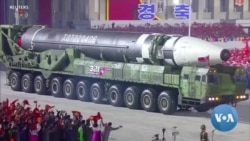North Korea's new intercontinental ballistic missile, unveiled at a military parade last week, appears designed to overwhelm U.S. missile defenses, security analysts say, a development that may spur the U.S. to add costly new interceptors.
The massive ICBM, the largest ever displayed by North Korea, is likely the “new strategic weapon” promised by the country’s leader, Kim Jong Un, at the beginning of the year.
The missile has not been flight-tested and its range is unknown, but North Korea has little need to prove its missiles can go farther; it already tested an ICBM in 2017 that can reach anywhere in the continental United States.
Instead, analysts say, North Korea is likely trying to show it can fit multiple nuclear warheads on a single ICBM, making it much more difficult and costly for U.S. missile defense systems to intercept.
Cost imbalance
“If you have multiple warheads coming out of that single missile, you now have to have multiple interceptors for each incoming warhead,” said Melissa Hanham, who closely tracks North Korea’s weapons program and is deputy director of the Vienna-based Open Nuclear Network.
The new ICBM, Hanham said, appears large enough to not only fit multiple warheads but also decoys, known as penetration aids, which could confuse missile defense systems.
“It’s not cheap to make missiles like this, but it's a lot cheaper than what the U.S. is now going to spend on missile defense,” Hanham added.
Missile defense has always been risky, as it is cheaper and easier to build a new missile than create a missile defense system involving sensors for detection and multiple interceptors for each missile, Hanham said.
To keep up with the changes in North Korea’s growing force, the U.S. will have to spend "hundreds of millions [of dollars] adding interceptors,” said Ankit Panda, a nuclear policy specialist at the Carnegie Endowment for International Peace.
“North Korea, meanwhile, even under economic sanctions, appears fully capable of continuing to expand its ICBM capabilities,” Panda added.
The United Nations expanded sanctions against North Korea in 2017 following a series of nuclear and ICBM tests by Pyongyang. The U.S. and North Korea engaged in nuclear negotiations in 2018 and 2019, but North Korea eventually walked away, angry at the U.S. refusal to relax the sanctions and provide other security guarantees.
100% confidence?
U.S. officials have dismissed concerns that North Korea’s rapidly evolving missile program could produce a weapon capable of evading ground-based U.S. missile defenses, based in the U.S. states of Alaska and California.
In January, General John Hyten, vice chairman of the Joint Chiefs of Staff, said he had “100% confidence” in the ability of U.S. missile defense systems against North Korea.
Independent defense analysts are much more skeptical about U.S. missile defense capabilities, especially if North Korea deploys ICBMs with multiple warheads.
“It is hard to see how Americans could be confident that a finite number of U.S. missile-defense interceptors would be sufficient to stop an attack by a volley of North Korean ICBMs with multiple warheads each,” wrote Markus Garlauskas and Bruce Perry, two former members of the U.S. intelligence community.
“Even if the United States were to attempt to build more interceptors to keep up, the costs could be prohibitive,” the analysts said.
Missile not perfect
North Korea’s new ICBM, which will presumably be named the Hwasong-16, does have strategic drawbacks.
Though the ICBM is technically road mobile, it is not as versatile as it may seem.
The missile is carried by a transporter erector launcher with 22 wheels. Depending on its turning radius, the launcher vehicle may be too large to travel on many North Korean roads, which are often in poor repair.
The large size of the missile also means it likely must travel with a team of fuel trucks and a crane to help erect it, Hanham said.
“If you were thinking about fueling that missile after it’s erected, it would take several hours,” she said -- which could allow U.S. reconnaissance sources to observe the missile’s setup.
Another drawback is that the missile remains untested, but that could soon change, analysts say.
In January, Kim said he no longer felt bound by his self-imposed moratorium on nuclear and long-range missile tests.
However, he may be reluctant to conduct a major test before the Nov. 3 U.S. presidential election. U.S. President Donald Trump has warned Kim against any big provocations before the vote.
“What I would expect is to see that ICBM tested next year,” said Bruce Klingner, a North Korea specialist at the Heritage Foundation.
“North Korea tends to … do something very provocative in the first year of a new U.S. or South Korean administration,” he said.
Hanham said while North Korea may watch to see what happens in the U.S. election, “they certainly have a powerful way of signaling their dissatisfaction now by testing this missile.”










